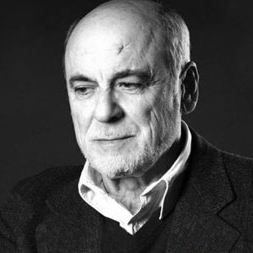
Augusto Mazzini
architect

architect
More than on the synthesis of urban panorama upon which the youthful figure of Catherine, leaning against the wind, is silhouetted in "The Meditation" (1994), I would like to pause briefly on the generalisation of these imago urbis: with particular reference, because of its emblematic value, to that which composes the "Medieval Panorama" of 1990. Here, we aren't referring to the flattened silhouette, (the "cardboard" architecture which Alison Smithson speaks of), but to the three dimensional consolidation of volumes, which stack and wrap themselves with much more construction than in the polymorphic transfiguration in "The Dream" (1992).
The "Sienese" quality of the architecture is unequivocal: the Torre del Mangia is unmistakable and the colour of the buildings, determined and established using the encaustic method is also Sienese, though represented in its particular substantial monochromy. As does the colour of the sky; blue-black, speak of the city. Neither do the marine fossil traces of spheres, vases and pilasters diminish the veracity of the urban-architectonic figure.
At the base of the configuration assigned to this Siena lies a mixture of impulses: not one alone. Certainly the desire to reinstate the gothic points of its towers: many more than those which made Mumford speak of "pincushions" when describing S. Gimignano. Without a doubt the attempt to establish something which continues to slip through our fingers like dreams: those of one's own city which are so deceitful, where space is both equal and yet so diverse. Certainly the memory of known urban iconography: of the 16th century panoramas by those fantastic engravers who progressively crowded the edified fabric of the more simple antique landscapes. Finally De Fleury's landscapes of the 1900, is that dilute the neogothic dream in a solidity similar to that of the reconstructed towers.
Just as its origin can't help but be; mother of all these forms, the extraordinary wooden panel of the 1300's with its three dimensional vision of a Siena by the sea. The very same encaustic method which has a lucidity and expressive technique all of its own and the imprinted spirality of the tangled urban form bring to mind Ernst in the forties: the painter of nightmarish forests, of inspired hills and of chemical nuptials. Enzo Santini is another painter who gambles his fortune on the way leading to the psyche.